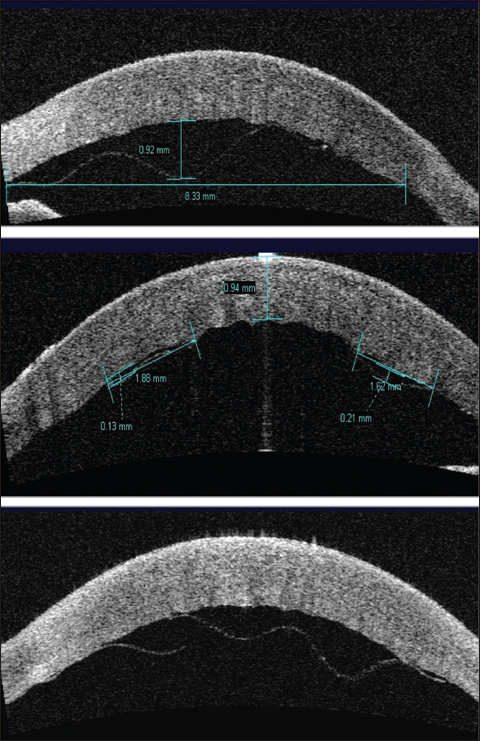Anterior segment OCT-based algorithm helps manage Descemet’s membrane detachment
Anterior segment OCT is a useful tool for diagnosing and guiding treatment for patients with Descemet’s membrane detachment whose cornea may not be easily evaluated with traditional methods.
In patients who have had ocular trauma or undergone eventful surgery, moderate to severe corneal edema can make it difficult for a surgeon to view and evaluate the cornea using a traditional slit lamp. Anterior segment OCT can give surgeons accurate measurements of the detachment and the extent of its severity, Dhivya A. Kumar, MBBS, MD (AIIMS), FICO, FAICO, told Ocular Surgery News.
“This is one of the indications where [anterior segment OCT] can really aid in diagnosis where there is poor visualization of the anterior segment or corneal haze. Young surgeons and even residents can be trained by using [anterior segment OCT and slit lamp] side by side along with their subjective findings. Secondly, once you diagnose the Descemet’s membrane detachment, it may be very subjective to quantify the extent and position for further analysis. Therefore, using the OCT, we can directly measure or quantify the extent of the detachment and grade the severity,” Kumar said.

Useful imaging tool
Following up with Descemet’s membrane detachment patients with anterior segment OCT to map changes in their status can take the subjectivity out of treatment, according to Kumar. Having a map to show a patient’s changes over time is also helpful for treatment options, she said.

Images: Kumar DA

In a 2015 study, Kumar and colleagues published an algorithm for using anterior segment OCT (Visante, Zeiss) based on the detachment’s height, extent, length and relation to the pupil, called the HELP protocol. The algorithm was developed over 2 years and fine-tuned in a pilot study to identify the threshold of detachments that reattach or worsen, she said.
“Height is the amount of separation of [Descemet’s membrane] from the cornea, and it has a direct role in recovery. Extent is the region of cornea involved, and it has an impact on the visual outcome and sequelae. Length, or chord length, aids us in following the progression of the [Descemet’s membrane] or improvement over the time period. The pupil zone is important because if the pupil zone is left untreated, it can cause a visual blur due to sequelae, like wrinkling or folds,” she said.
Zone classification is key
The height and length of the Descemet’s membrane detachment is measured with anterior segment OCT in millimeters and classified to one of three zones. Zone 1 is central, or 5 mm; zone 2 is paracentral, or 5 mm to 8 mm; and zone 3 is periphery, or greater than 8 mm.
Knowing the height or length of a detachment and its relationship to the pupil helps manage postoperative treatment. The anterior segment OCT HELP algorithm also aids in early diagnosis, prompt treatment and early surgical intervention in cases involving the central cornea and pupil, thereby preventing functional visual loss, Kumar said.




The Descemet’s membrane detachment classified zone should guide surgeons in determining if a patient needs early surgical intervention or if a wait-and-watch approach can be used, Kumar said.
“The central 5-mm zone is very crucial as compared with the periphery 3-mm zone as the impact on visual acuity is more when the central 3- to 5-mm zone is affected. Hence, zone 1 has been given more priority in management,” she said.
Crucial for diagnosis, treatment
Kumar said anterior segment OCT is a crucial tool in diagnosing and charting a treatment course for Descemet’s membrane detachment. Spontaneous resolution of the detachment can occur in some patients, but 4 weeks of observation may be required in others.
Timing of surgery is crucial in patients who require it, but on the other hand, anterior segment OCT can help avoid unnecessary surgical intervention and surgery-related complications in patients in whom it can resolve spontaneously, she said. – by Robert Linnehan
- Reference:
- Kumar DA, et al. J Cataract Refract Surg. 2015;doi:10.1016/j.jcrs.2015.01.020.
- For more information:
- Dhivya A. Kumar, MBBS, MD (AIIMS), FICO, FAICO, can be reached at Dr. Agarwal’s Eye Hospital and Eye Research Centre, 19 Cathedral Road, Chennai 600086, India; email: susruta2002@gmail.com.
Disclosure: Kumar reports no relevant financial disclosures.
